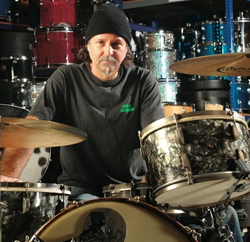
What’s the next step to making drums sound good after you change the heads?
I tune the drums on the high side for starters. For tuning, you’ve got to keep all of the tension rods even so they have the same tension at each lug. You hit the head an inch in front of the lug, and if you do it enough times you’ll hear which ones are higher and which are lower. The pitch should be the same at each lug, then when you hit it in the center you should have a nice even decay. I do that at the top and the bottom head.
Are they both tuned to the same pitch?
I start it that way, and then take the bottom head down a third to a fifth below the top head.
I’ve been in awe of the way you can get each drum to sound so separate without any sympathetic vibrations from the other drums. Even when the other drums do vibrate, it’s still pleasing. How do you do that?
Part of that is having good drums and that’s the reason why I have so many; so I can cherry-pick the ones that sound really good together. The other thing is to have the edges of the shells cut properly. If you take the heads off, the edges should be flat. I check it with a piece of granite that I had cut that’s perfectly flat and about two inches thick. I’ll put the shell on the granite and have a light over the top of the shell. Then I’ll get down at where the edge of the drum hits the granite. If you see light at any point then you have a low spot. So that’s the first thing; to make sure that your drums are “true.”
The edges should be looked at anyway because you don’t want to have a flat drum with a square edge; you want it to have a bevel to it. If you have a problem with a drum, you should just send it in to the manufacturer. I don’t recommend anyone trying to cut the edges of their drums themselves. It doesn’t cost that much and it’s something that should be looked at by someone who knows what to look for.
Once you get those factors in play, then tuning is a lot easier. I tend to tune each drum as far apart as the song will permit. It’s easy to get the right spread between a 13 and a 16 inch tom, but it’s more difficult to get it between a 12 and a 13. What I try to do is to take the 12 up to a higher register and the 13 down a little. The trick to all that is the snare drum because the biggest problem that people have is when they hit the snare drum there’s a sympathetic vibration with the toms.
The way I look at that is to get the snare drum where you want it first because it’s way more important than the way the toms are tuned. You hear that snare on at least every two and four.
The kick and snare are the two most important drums and I tune the toms around that and make sure that the rack toms aren’t being set off by the snare. The snare is probably the most important drum in the set because for me it’s the voice of the song. I try to pick the right snare drum for the song because that’s where you get the character.
Do you tune to the key of a song?
Not intentionally. I have people who ask me to do that, and I will if that’s what they want, but usually I just tune it so it sounds good with the key of the song. If there’s a ring in the snare, I try to get it to ring in the key of the song, but sometimes I want the kit just to stand on its own because if it is tuned in the key of the song and one of the players hit the note that the snare or kick is tuned to, then the drum kind of gets covered up, so I tend to make it sound good with the song rather than in-pitch with the song.
Would you tune things differently if you have a heavy hitter as opposed to someone with a light touch?
Yeah, a heavy hitter will get more low end out of a drum that’s tuned higher just because of the way he hits, so I usually tune a drum a little tighter. I might move into different heads as well, like an Emperor or something thicker.
